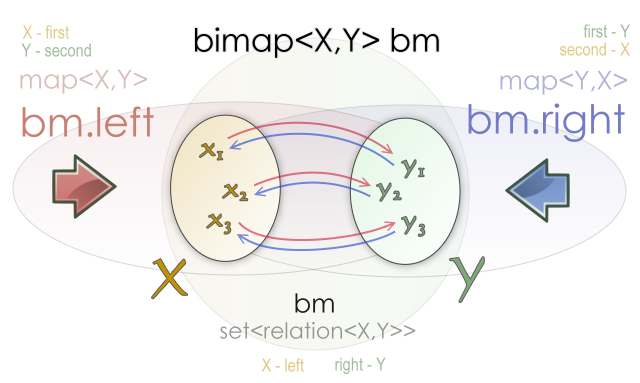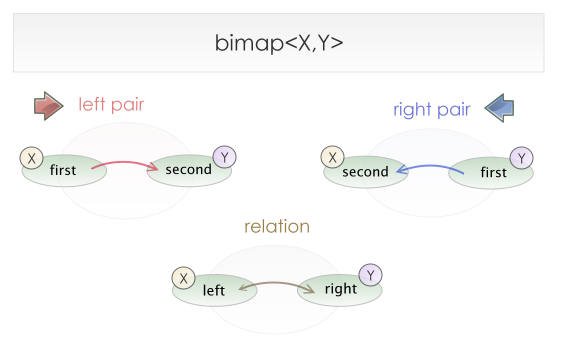A Bimap is a data structure that represents bidirectional relations between
elements of two collections. The container is designed to work as two opposed
STL maps. A bimap between a collection X
and a collection Y can be viewed
as a map from X to Y (this view will be called the left
map view) or as a map from Y
to X (known as the right
map view). Additionally, the bimap can also be viewed as a set of
relations between X and Y (named the collection of relations
view).
The following code creates an empty bimap container:
typedef bimap<X,Y> bm_type;
bm_type bm;
Given this code, the following is the complete description of the resulting
bimap. []
-
bm.left is signature-compatible with std::map<X,Y>
-
bm.right is signature-compatible with std::map<Y,X>
-
bm is signature-compatible
with std::set< relation<X,Y> >

You can see how a bimap container offers three views over the same collection
of bidirectional relations.
If we have any generic function that work with maps
template< class MapType >
void print_map(const MapType & m)
{
typedef typename MapType::const_iterator const_iterator;
for( const_iterator iter = m.begin(), iend = m.end(); iter != iend; ++iter )
{
std::cout << iter->first << "-->" << iter->second << std::endl;
}
}
We can use the left map view and the right map
view with it
bimap< int, std::string > bm;
...
print_map( bm.left );
print_map( bm.right );
And the output will be
1 --> one
2 --> two
...
one --> 1
two --> 2
...
The relation class represents
two related elements. The two values are named left and right to express the
symmetry of this type. The bimap pair classes are signature-compatible with
std::pairs.

A convinience header is avaiable in the boost directory:
#include <boost/bimap.hpp>
Lets define a bidirectional map between integers and strings:
typedef boost::bimap< int, std::string > bm_type;
bm_type bm;
Remember that bm alone can
be used as a set of relations. We can insert elements or iterate over them
using this view.
bm.insert( bm_type::value_type(1, "one" ) );
bm.insert( bm_type::value_type(2, "two" ) );
std::cout << "There are " << bm.size() << "relations" << std::endl;
for( bm_type::const_iterator iter = bm.begin(), iend = bm.end();
iter != iend; ++iter )
{
std::cout << iter->left << " <--> " << iter->right << std::endl;
}
bm.left works like a std::map<
int, std::string
>. We use it in the same way we will
use a standard map.
 typedef bm_type::left_map::const_iterator left_const_iterator;
for( left_const_iterator left_iter = bm.left.begin(), iend = bm.left.end();
left_iter != iend; ++left_iter )
{
std::cout << left_iter->first << " --> " << left_iter->second << std::endl;
}
typedef bm_type::left_map::const_iterator left_const_iterator;
for( left_const_iterator left_iter = bm.left.begin(), iend = bm.left.end();
left_iter != iend; ++left_iter )
{
std::cout << left_iter->first << " --> " << left_iter->second << std::endl;
}
 bm_type::left_const_iterator left_iter = bm.left.find(2);
assert( left_iter->second == "two" );
bm_type::left_const_iterator left_iter = bm.left.find(2);
assert( left_iter->second == "two" );
 bm.left.insert( bm_type::left_value_type( 3, "three" ) );
bm.left.insert( bm_type::left_value_type( 3, "three" ) );

|
The type of bm.left is bm_type::left_map
and the type of bm.right is bm_type::right_map
|

|
bm_type::left_-type- can be used as a shortcut for
the more verbose bm_type::left_map::-type-
|

|
This line produces the same effect of bm.insert(
bm_type::value_type(3,"three") ); |
bm.right works like a std::map<
std::string, int >. It
is important to note that the key is the first type and the data is the second
one, exactly as with standard maps.
bm_type::right_const_iterator right_iter = bm.right.find("two");
assert( right_iter->second == 2 );
assert( bm.right.at("one") == 1 );
bm.right.erase("two");
 bm.right.insert( bm_type::right_value_type( "four", 4 ) );
bm.right.insert( bm_type::right_value_type( "four", 4 ) );

|
This line produces the same effect of bm.insert(
bm_type::value_type(4,"four") ); |
The main difference between bimap views and their standard containers counterparts
is that, because of the bidirectional nature of a bimap, the values stored
in it can not be modified directly using iterators. For example, when a std::map<X,Y> iterator
is dereferenced the return type is std::pair<const X,
Y>,
so the following code is valid: m.begin()->second = new_value;.
However dereferencing a bimap<X,Y>::left_iterator
returns a type that is signature-compatible with a std::pair<const X, const Y>
bm.left.find(1)->second = "1";
If you insert (1,"one") and (1,"1") in a std::map<int,std::string> the second insertion will have no effect.
In a bimap<X,Y> both keys have to remain unique. The insertion
may fail in other situtions too. Lets see an example
bm.clear();
bm.insert( bm_type::value_type( 1, "one" ) );
bm.insert( bm_type::value_type( 1, "1" ) ); bm.insert( bm_type::value_type( 2, "one" ) );
assert( bm.size() == 1 );
Look how you can reuse code that is intend to be used with std::maps, like
the print_map function in this example.
Go to source code
#include <string>
#include <iostream>
#include <boost/bimap.hpp>
template< class MapType >
void print_map(const MapType & map,
const std::string & separator,
std::ostream & os )
{
typedef typename MapType::const_iterator const_iterator;
for( const_iterator i = map.begin(), iend = map.end(); i != iend; ++i )
{
os << i->first << separator << i->second << std::endl;
}
}
int main()
{
typedef boost::bimap< std::string, int > results_bimap;
typedef results_bimap::value_type position;
results_bimap results;
results.insert( position("Argentina" ,1) );
results.insert( position("Spain" ,2) );
results.insert( position("Germany" ,3) );
results.insert( position("France" ,4) );
std::cout << "The number of countries is " << results.size()
<< std::endl;
std::cout << "The winner is " << results.right.at(1)
<< std::endl
<< std::endl;
std::cout << "Countries names ordered by their final position:"
<< std::endl;
print_map( results.right, ") ", std::cout );
std::cout << std::endl
<< "Countries names ordered alphabetically along with"
"their final position:"
<< std::endl;
print_map( results.left, " ends in position ", std::cout );
return 0;
}
The output of this program will be the following:
The number of countries is 4
The winner is Argentina
Countries names ordered by their final position:
1) Argentina
2) Spain
3) Germany
4) France
Countries names ordered alphabetically along with their final position:
Argentina ends in position 1
France ends in position 4
Germany ends in position 3
Spain ends in position 2
For information on function signatures, see any standard library documentation
or read the reference section
of this documentation.
![[Caution]](../../../../../doc/src/images/caution.png) |
Caution |
Be aware that a bidirectional map is only signature-compatible with standard
containers. Some functions may give different results, such as in the case
of inserting a pair into the left map where the second value conflicts with
a stored relation in the container. The functions may be slower in a bimap
because of the duplicated constraints. It is strongly recommended that you
read The full tutorial if
you intend to use a bimap in a serious project.
|
 Boost
C++ Libraries
Boost
C++ Libraries









![[Caution]](../../../../../doc/src/images/caution.png)